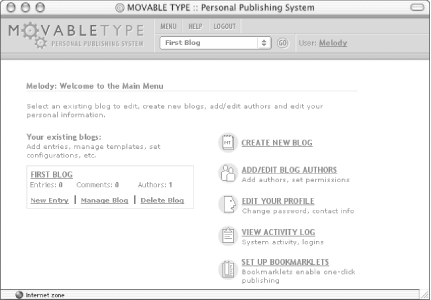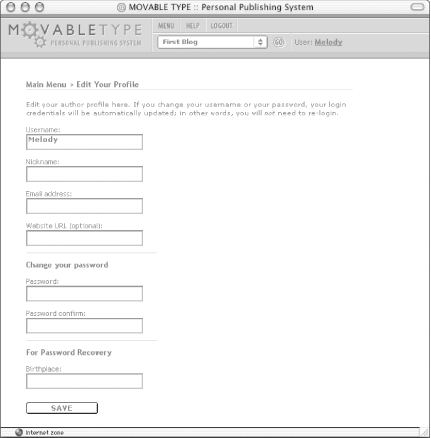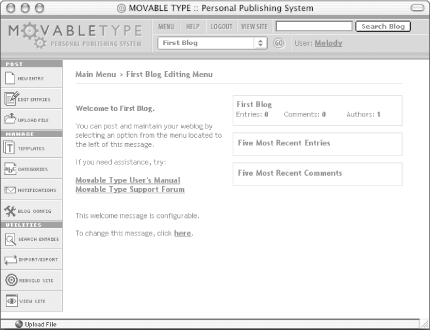

|
|
5.3 Using Movable TypeNow that you have installed Movable Type, you are ready to start using the system. The first steps are to log in and change your username and password, because the system by default always uses the same username and password. The next step is to configure your first blog. 5.3.1 Logging InOpen your web browser and point it at the URL for mt.cgi on your site. mt.cgi is the main Movable Type application. For example, if your site is http://www.your-site.com, and you installed the application into the /mt directory, type http://www.your-site.com/mt/mt.cgi to access Movable Type. You should see the login prompt as shown in Figure 5-11. If you get an Internal Server error, check the permissions on mt.cgi and check that you uploaded the CGI scripts using ASCII mode. If you see a login prompt but the images do not appear, you may need to either move your images, docs, and styles.css out of your cgi-bin, or if you have already done that, adjust the Static Web Path setting in mt.cfg. See Section 5.2.5 earlier in this chapter. Figure 5-11. Login screen Log in with the author name "Melody" and the password "Nelson." Case is important. The author name "melody" does not work. After a successful login, you see the screen in Figure 5-12. This is the Main Menu. On the left of the screen is a list of the blogs to which you have access; on the right is a list of system-wide options. Figure 5-12. Main menu Currently the default username and password can still be used to log in to Movable Type. For the sake of security, the first thing you should is to change your author name and password. To do so, click Edit Your Profile. You will see the screen in Figure 5-13. Change the username and password, then click Save. Figure 5-13. Edit Your Profile screen 5.3.2 Configuring Your BlogThe next thing to do is configure your first blog. A blog called First Blog already exists in the system. This blog gives you a head start in setting up your first blog in Movable Type. First Blog ships with default templates, which can be edited, customized, or deleted from the system. They provide a good starting point for blog customization and will give you a sense of familiarity with the Movable Type template tags and structure. To configure the blog for your own purposes, click on the link to First Blog under Your Existing Blogs. You now see the main Editing menu for First Blog (Figure 5-14). Figure 5-14. Editing menu To start configuring your blog, click on Blog Config from the left navigation bar. In the blog configuration screen (Figure 5-15), name your blog in the Blog Name field. Then fill in the path and URL information (Local Site Path, Site URL, Local Archive Path, and Archive URL). Values for Local Site Path and Site URL are provided by default to give you a sense of what the paths should look like. All four of these fields must be filled in. Figure 5-15. Configuration You should have already created the directories for your blog in "Installation Directories" earlier in this chapter. Fill in the local paths (site and archive) with the full paths to those directories, and enter the URLs corresponding to those directories. Finally, select your timezone from the Timezone pulldown menu. Click Save to save the configuration changes. Note that there are many configuration options that can be set for each blog in the system. First Blog contains sensible defaults for all of these options. Chapter 8 contains more details on the preferences supported by the system. |

|
|